The Grand Canal is a channel in Venice, Italy. It forms one of the major water-traffic corridors in the city.

Venetian Gothic is the term used for the particular form of Italian Gothic architecture typical of Venice, originating in local building requirements, with some influence from Byzantine architecture, and some from Islamic architecture, reflecting Venice's trading network. Very unusually for medieval architecture, the style is both at its most characteristic in secular buildings, and the great majority of survivals are secular.

Santa Maria Formosa, formally The Church of the Purification of Mary, is a church in Venice, northern Italy. It was erected in 1492 under the design by Renaissance architect Mauro Codussi. It lies on the site of a previous church dating from the 7th century, which, according to tradition, was one of the eight founded by San Magno, bishop of Oderzo. The name "formosa" relates to an alleged appearance of the Holy Virgin disguised as a voluptuous woman1.

The Palazzo Clary is a Late Renaissance Venetian palace facing the Giudecca Canal alongside the fondamenta Zattere by the ponte longo in Venice's Dorsoduro. It was originally built in the 17th century for a Venetian noble family. In the early 19th century, the palazzo is known as Palazzo Clary, named after it was bought by the prince Clary-Aldringen. The neighboring building is Palazzo Giustinian Recanati.
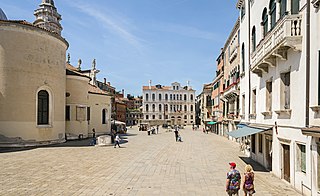
Campo Santa Maria Formosa is a city square in Venice, Italy.
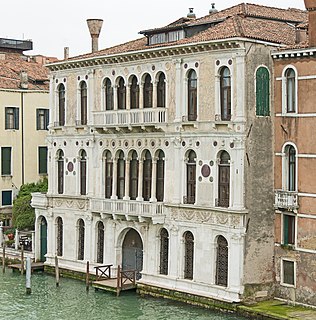
Palazzo Contarini Dal Zaffo, also known as Palazzo Contarini Polignac is a large palace in Venice, located in the Dorsoduro district, overlooking the Grand Canal, in an intermediate position between Palazzo Brandolin Rota and Palazzo Balbi Valier.

Palazzo Nani is a Renaissance palace in the Cannaregio district of Venice, Italy.
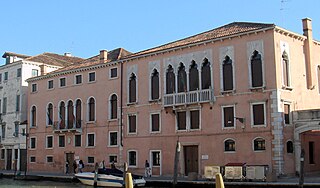
Palazzo Testa is a small Gothic palace in Venice, Italy, located in the Cannaregio district and overlooking the Canale di Cannaregio.

Palazzo Bellavite is a 16th-century Venetian palace, located in Campo San Maurizio, in the San Marco district. It is also known as Palazzo Bellavite Baffo, because the last member of the Baffo family lived there.

Palazzo Dandolo Paolucci is a Renaissance palace in Venice, Italy, located in the San Polo district and overlooking the Grand Canal. The palazzo neighbors Palazzo Dolfin and Palazzo Civran Grimani.

Palazzo Giustinian Pesaro is a Gothic palace located in Venice, Italy, in the Cannaregio district and overlooking the Grand Canal. The palazzo is situated between Ca' d'Oro and Palazzo Morosini Sagredo.

Palazzo Giovanelli is a palace in Venice, located in the Santa Croce district, overlooking the right side of the Grand Canal and the Rio di San Giovanni Decollato, before the Fondaco dei Turchi.

Palazzo D'Anna Viaro Martinengo Volpi di Misurata, also known as Palazzo Talenti D'Anna Volpi, is a Renaissance palace in Venice, Italy, located in the San Marco district, overlooking the left side of the Grand Canal, between Palazzo Tron and Casa Marinoni and opposite of Palazzo Donà a Sant'Aponal.

Palazzo Falier is a civil building located in Venice, Italy in the Cannaregio district. The palazzo is particularly known for having been the home of Marin Falier, Doge of the Republic of Venice, who was executed for attempting a coup d'état.
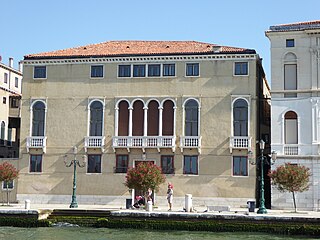
Palazzo Giustinian Recanati is a palace in Venice, Italy, located in the Dorsoduro district and overlooking the Giudecca Canal, just to the left of Palazzo Clary.
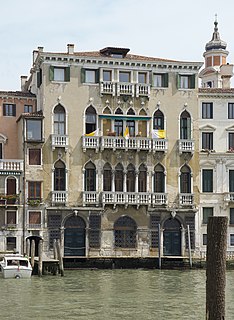
Palazzo Michiel del Brusà is a palace located in Venice, more precisely in the Cannaregio district, and overlooking the Grand Canal. The building is located between Palazzo Michiel dalle Colonne and Palazzo Smith Mangilli Valmarana.
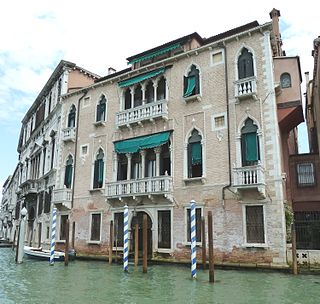
Palazzo Erizzo Nani Mocenigo is a palace in Venice located in the San Marco district and overlooking the Grand Canal between Palazzo Da Lezze and Palazzo Contarini delle Figure.
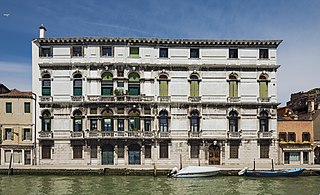
Palazzo Surian Bellotto is a Baroque palace in Venice, Italy. The palazzo is located in the Cannaregio district and overlooks the Cannaregio Canal.

Palazzo Vitturi is a palace in Venice, Italy located in the Castello district, on the north-eastern side of Campo Santa Maria Formosa, of which the palazzo is the oldest building. The palace is mentioned in the works of Sansovino.
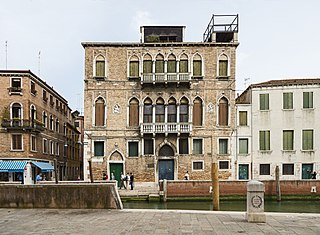
Palazzo Barbarigo Nani Mocenigo is a Gothic palace in Venice, Italy located in the Dorsoduro district, along the Nani embankment on the San Trovaso river, near the campo of the same name.
























